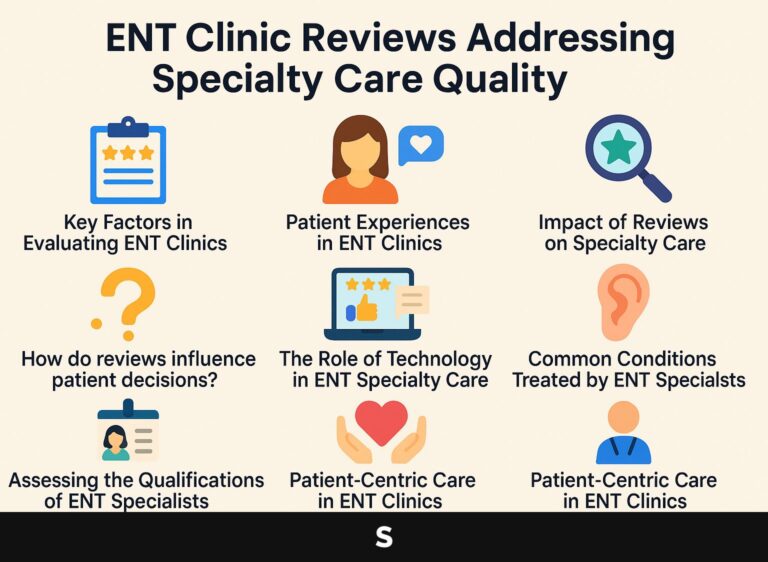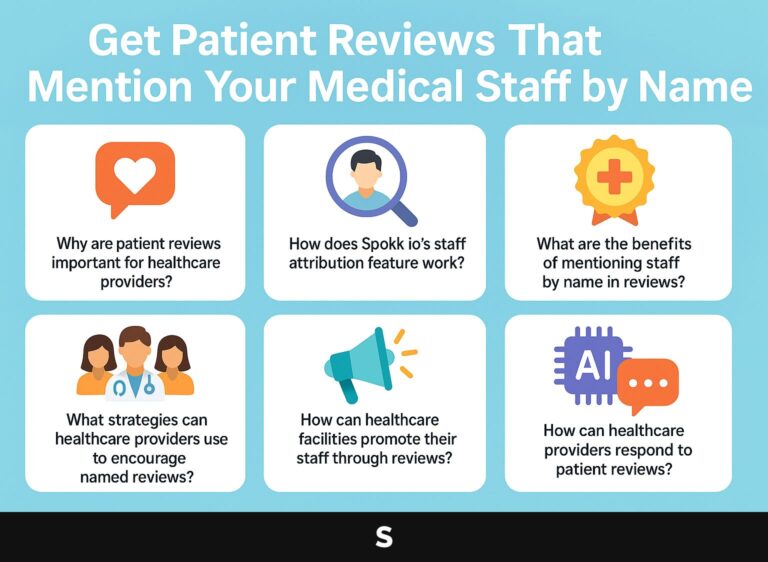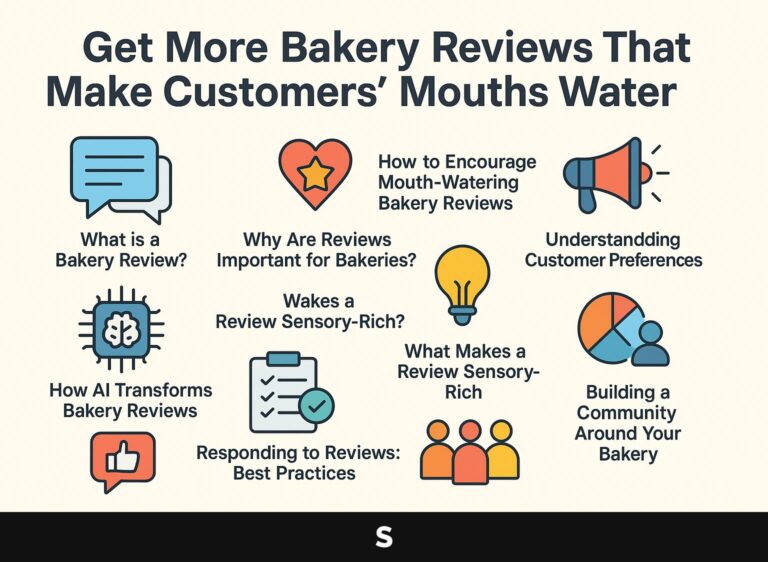Get Spa Reviews That Capture the Full Experience
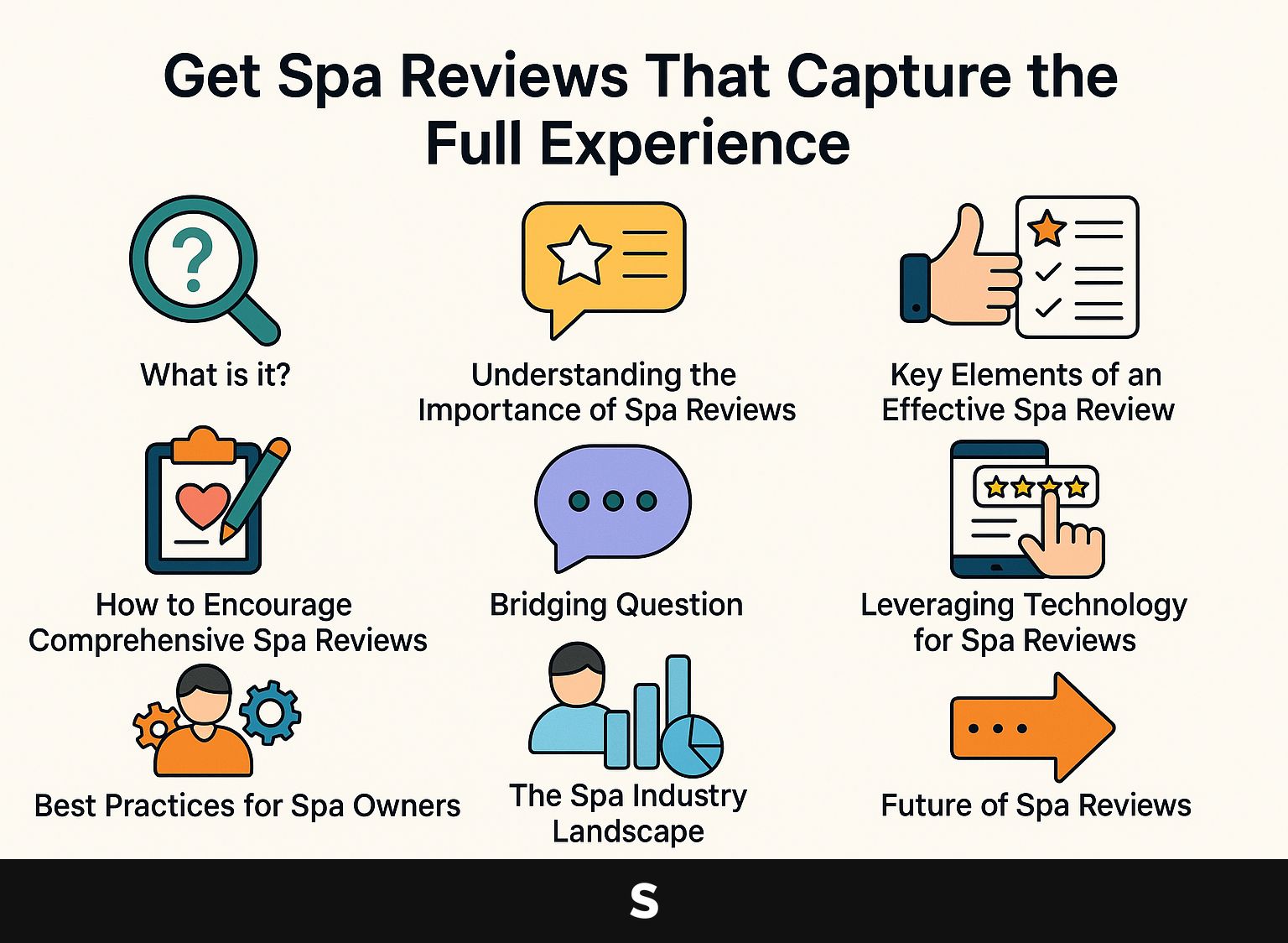
When searching for the perfect beauty spa, customer feedback can make all the difference. Generic phrases like “so relaxing” fail to convey the true client experience. At Spokk.io, we change how people think about Google reviews by highlighting the atmosphere, professionalism, and impact of anti-aging treatments. This article will help you write reviews that connect with potential clients and improve your spa’s reputation. Learn how thorough information can help your business succeed and build customer confidence.
Key Takeaways:
- Get Spa Reviews That Capture the Full Experience – What is it?
- The Significance of Spa Reviews
- Key Elements of an Effective Spa Review
- How to Get Detailed Spa Reviews
- Bridging Question
- Leveraging Technology for Spa Reviews
- Best Practices for Spa Owners
- The Spa Industry Overview
- Future of Spa Reviews
- Frequently Asked Questions
Get Spa Reviews That Capture the Full Experience – What is it?
Reviews of spas are important for sharing the atmosphere and how clients feel about their visits, which affects their decisions about wellness services.
What makes a spa review effective?
A good spa review should clearly describe the soothing atmosphere, customized attention, and the overall customer experience that encourages emotional comfort.
To write an effective review, think about these important points:
- describe the ambiance with vivid imagery-mention soft lighting, soothing music, or calming scents.
- Highlight the staff’s professionalism by noting their careful attention and competence.
- Share personal anecdotes that reflect the emotional impact of treatments, such as a sense of rejuvenation or tranquility.
- Discuss the overall value of the experience, comparing it to others.
Describing the staff as very attentive and making you feel like the only guest can draw in more customers.
How do reviews influence spa choices?
Reviews play a big role in spa choices by showing others’ experiences and helping people decide if they want to visit, whether they are new or returning customers.
In fact, data shows that 70% of customers trust online reviews as much as personal recommendations, underscoring their significance.
Positive reviews improve customer loyalty; spas with higher ratings often see an increase in repeat visits. For instance, a spa that consistently receives four or five-star reviews is likely to retain 50% more clients than those with lower ratings.
To make use of this power, ask happy customers to write reviews on sites like Google or Yelp, and clearly show their testimonials on your website. This strategy increases trust and helps in gaining new clients.
The Significance of Spa Reviews
Knowing the value of spa reviews is important for both customers and spa owners since they help shape the customer experience and build trust. For those aiming to enhance this aspect, mastering effective feedback collection (see our guide on how to collect customer feedback for spas) can be pivotal.
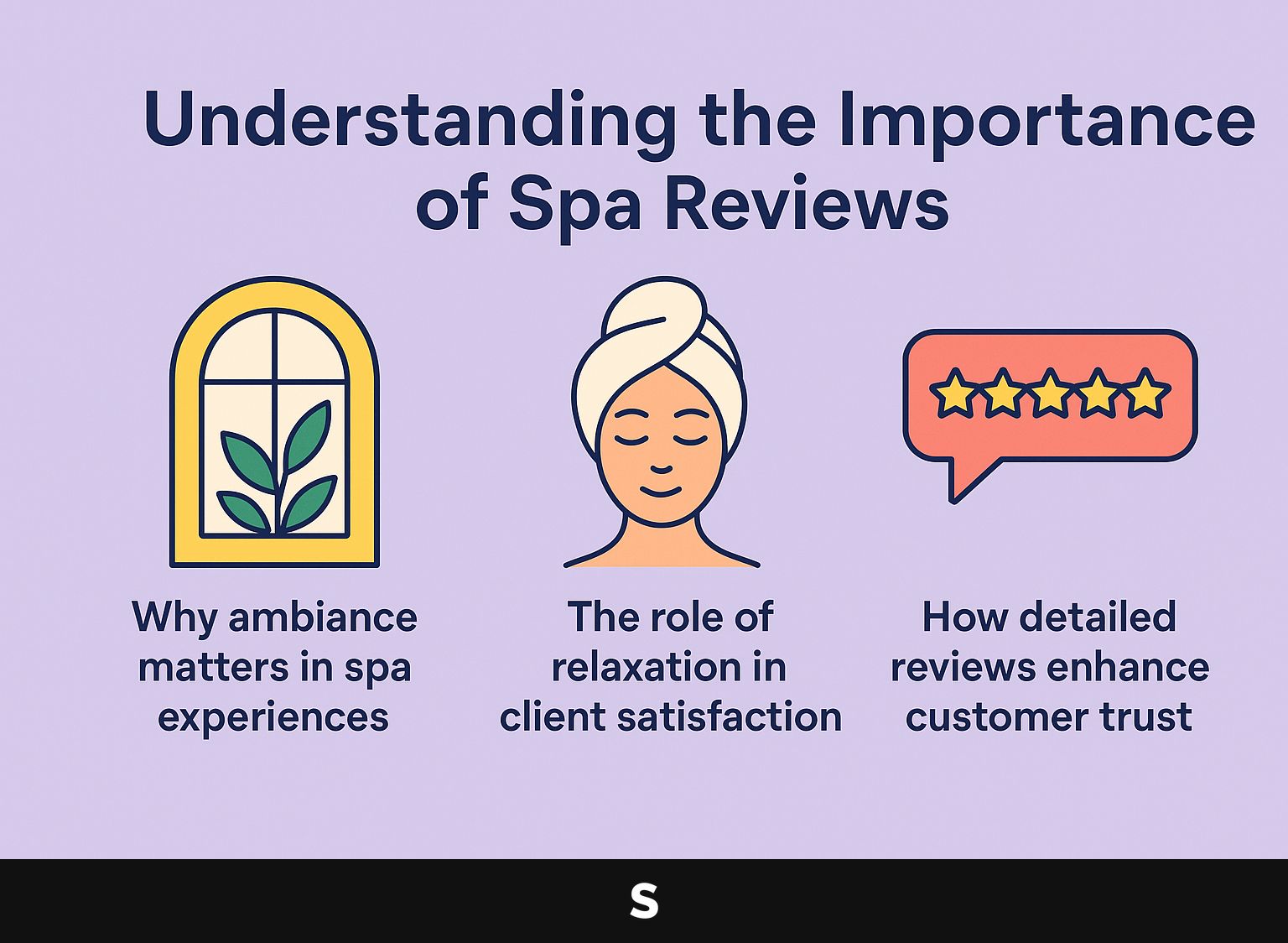
Why ambiance matters in spa experiences
The ambiance of a spa directly influences emotional well-being, setting the tone for relaxation and rejuvenation from the moment clients walk in.
To improve the atmosphere in a spa, concentrate on three main aspects: lighting, scents, and decor.
-
Soft, dim lighting creates a tranquil environment; consider using dimmers or Himalayan salt lamps for a warm glow.
-
Scents such as lavender and eucalyptus can be introduced through essential oil diffusers, promoting relaxation.
-
Successful spa examples like Bliss and Aveda use nature-inspired decor, with natural materials like wood and stone to create a calming atmosphere.
These strategies create a calm environment that helps clients relax and recharge.
The role of relaxation in client satisfaction
Relaxation is a key component of client satisfaction, with studies showing that 85% of spa-goers prioritize stress relief and relaxation over other factors.
This emphasis on relaxation significantly influences overall satisfaction metrics. For example, clients say they feel 30% more satisfied after treatments like aromatherapy and deep tissue massage, which are designed to relieve tension.
Treatment types such as guided meditations, hydrotherapy, and yoga sessions are also effective. Using various relaxation methods can improve how clients feel about their experience and their opinions, leading to more success for the business and stronger customer loyalty.
How detailed reviews build customer trust
Detailed reviews help build customer trust by giving real information about the spa experience, helping potential clients make informed decisions.
For example, clients may talk about their customized treatments, explaining how staff adjusted aspects to meet personal needs.
Reviews that focus on services, such as a deep tissue massage or a refreshing facial, can demonstrate the therapist’s skills.
Look for comments about the ambiance and cleanliness of the facility to gauge overall professionalism.
Providing information such as when appointments are available and the speed of customer service replies helps new clients understand what to expect, increasing their confidence.
Key Elements of an Effective Spa Review
Important parts of a good spa review are clear descriptions of the atmosphere, staff’s professionalism, and detailed accounts of treatments.
These help potential clients understand what to expect.
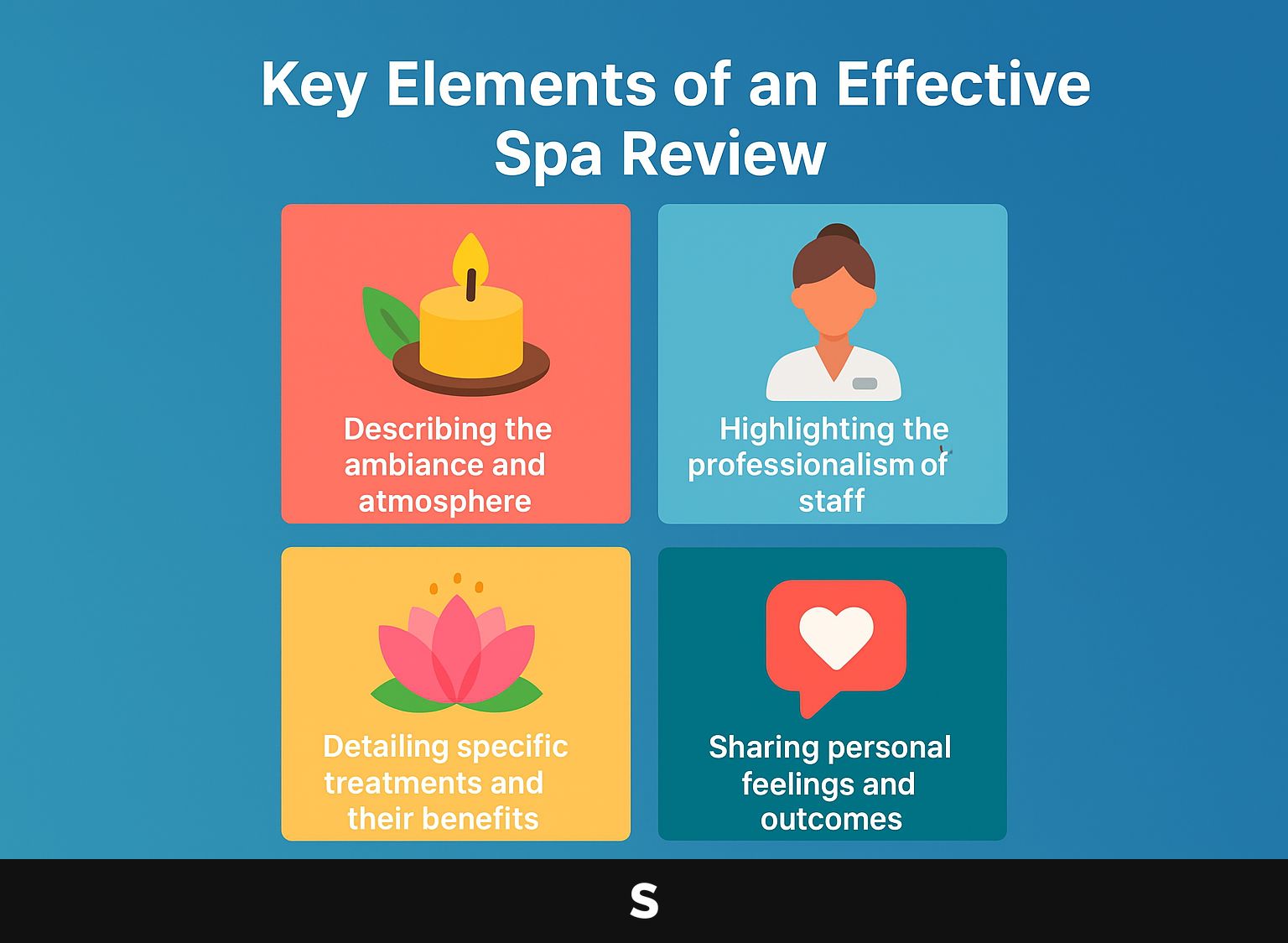
Describing the ambiance and atmosphere
When describing the ambiance and atmosphere, reviewers should focus on sensory experiences such as scents, lighting, and sounds that contribute to a relaxing environment.
To articulate ambiance effectively, use vivid sensory language. For instance, describe how the flickering candlelight casts soft shadows on the walls, creating a warm, inviting glow.
Include sounds like the soft crackle of a fireplace, which can bring about a sense of warmth and comfort. Mention scents, such as the soothing aroma of lavender or fresh-brewed coffee, to further immerse the reader in the experience.
The room smelled like vanilla, and soft jazz music played, helping me relax.
Highlighting the professionalism of staff
Pointing out the professionalism of staff in reviews is important because it shows the quality of service clients can look forward to and improves the spa’s reputation.
To effectively evaluate and describe staff interactions, focus on specific attributes such as attentiveness, skill level, and training background.
For instance, ask clients about their experiences with staff responsiveness during treatments or consultations. A testimonial might say, “The therapist was excellent, listened closely to my needs, and made the session calming and customized.”
Regular staff training sessions can help improve skills, keeping team members updated with best practices to deliver excellent client service.
Detailing specific treatments and their benefits
Explaining specific treatments in reviews, along with their benefits, gives potential customers a clear idea of what to expect and helps them make informed decisions.
For example, if reviewing a skincare routine, include the names of products like ‘Retinol 0.5% Serum’ used nightly for wrinkle reduction, or ‘Vitamin C 20% Serum’ applied in the morning for brightening.
Mention the time frame for results, such as ‘expect noticeable improvements after six weeks’. Discuss the application method – like massaging the serum onto clean skin for better absorption.
This thorough method educates readers and strengthens trust in your advice.
Sharing personal feelings and outcomes
Including your own feelings and results in a review makes it feel real and helps readers connect with the experience.
To create an engaging story, begin by describing your emotions before treatment. Describe any fears, hopes, or expectations. For instance, if you were anxious about side effects, articulate that concern.
During treatment, capture the emotional ups and downs, perhaps noting a day you felt particularly optimistic or challenged.
Afterward, reflect on how the outcome matched your initial hopes. Sharing certain experiences, like a helpful talk with a doctor or noticeable progress in health, can strongly connect with readers who are going through similar situations.
How to Get Detailed Spa Reviews
Getting thorough spa reviews needs a thoughtful approach where clients feel comfortable sharing their thoughts, and they get guidance on what information to include.
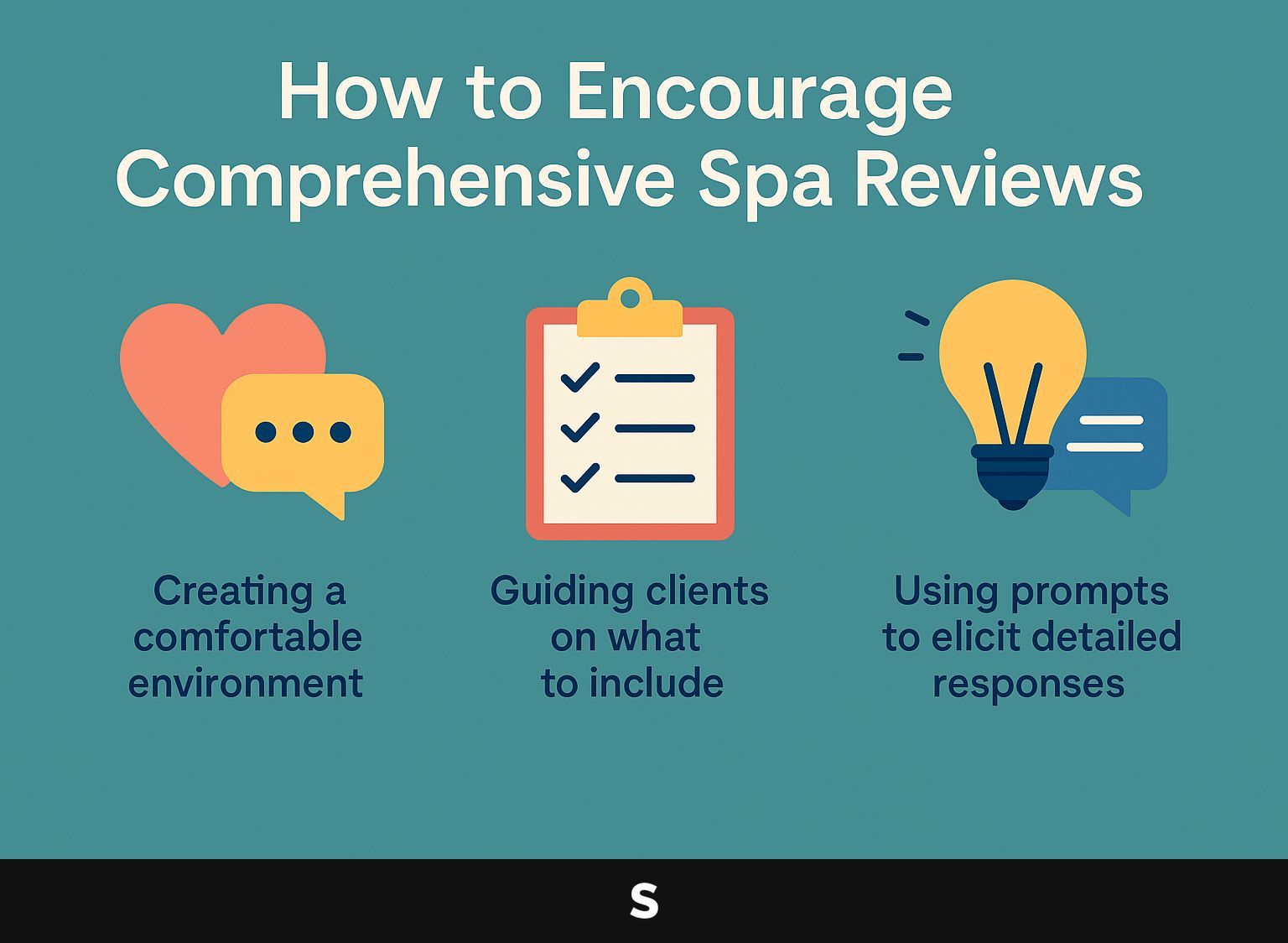
Creating a comfortable environment for feedback
Making clients feel comfortable and valued during their spa visit helps create a friendly space for feedback.
Begin by welcoming clients by name and inquiring about what they like. Follow this by creating a peaceful environment-playing gentle music, using soothing fragrances, and providing cozy seating can greatly improve relaxation.
Spas like The Four Seasons Spa and Canyon Ranch excel at this; they offer guided meditations before treatments, ensuring clients feel at ease.
After treatments, initiate follow-up conversations to gather feedback, showing genuine interest in their experience. These practices encourage open communication and strengthen long-term client relationships.
Guiding clients on what to include in their reviews
Helping clients know what to write in their reviews makes sure they give detailed feedback that points out important parts of their spa visit.
Encourage clients to cover specific areas such as the ambiance, which includes dcor and lighting, as well as the range of treatments available, like massages and facials.
They should also note the professionalism and friendliness of the staff, which can significantly impact their overall satisfaction. Suggest they rate each aspect on a scale of 1-5 and include any standout moments, such as a particularly effective treatment or an exceptional therapist.
By following this structure, reviews become more informative and helpful to others considering a visit.
Getting detailed answers with prompts
Getting clients to give detailed answers can greatly improve the feedback you get, offering a better look into their experience.
Effective prompts include sensory elements and feelings to make an impression.
For instance, instead of asking “How was your experience?” try “Can you describe how you felt when you first used our product?” This invites clients to tap into their emotions and sensations, leading to more vivid descriptions.
Similar prompts include:
- “What specific features stood out to you, and why?”
- “How did the product change your routine?”
These questions can give your team useful information, helping to improve products and communicate more effectively with customers.
Bridging Question
As spas look to make their review process better, AI technology offers a strong way to improve the detail and emotional impact of client feedback.
How can AI improve the review writing process?
AI can improve the way reviews are created by automatically gathering and examining customer feedback, providing detailed and customized results.
For example, Spokk.io uses natural language processing to analyze feedback, picking out important emotional and sensory words. This helps spas get reviews like, “The relaxing atmosphere and professional therapy left me feeling completely refreshed,” truly reflecting client experiences.
By selecting specific prompts or options in Spokk.io, spas can adjust reviews to highlight details like the ambiance, the quality of service, or the effectiveness of treatments. This helps improve their marketing plans and draw in more clients.
Leveraging Technology for Spa Reviews
Using technology for spa reviews simplifies getting feedback and improves the information collected from clients.
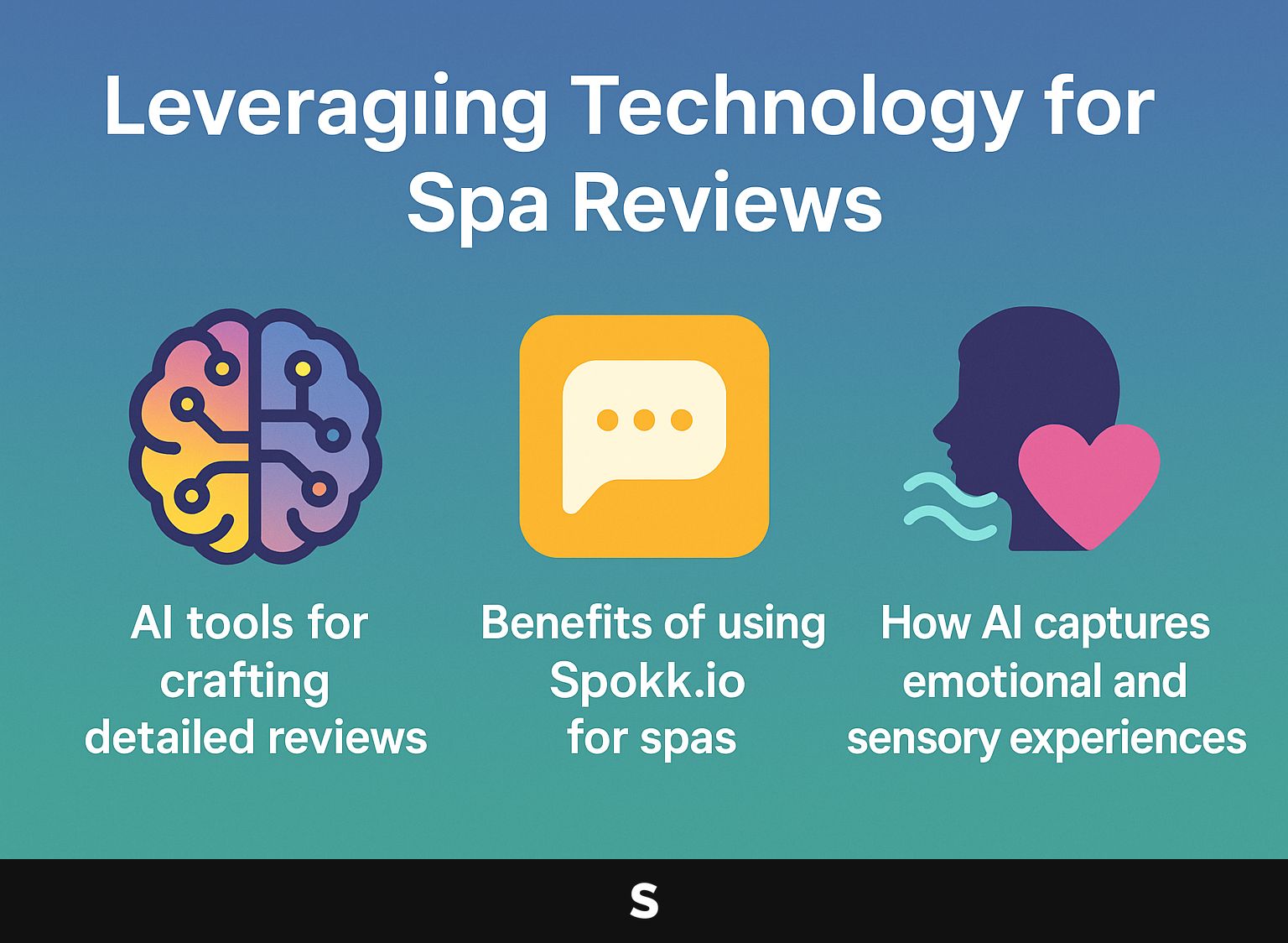
AI tools for crafting detailed reviews
AI tools like Spokk.io simplify the process of creating reviews, turning client feedback into engaging stories that show the spa’s atmosphere and service quality.
Different AI tools can help make the review process better for spas. For example, Spokk.io is great at creating detailed reviews by looking at customer feedback using natural language processing, which makes the reviews more interesting and genuine.
Similarly, platforms like Trustpilot offer analytics to track client feedback trends, while GatherUp enables the collection of onsite reviews effortlessly.
Review Trackers links various review platforms, offering a full view of customer feedback. These tools simplify collecting reviews and motivate more clients to provide feedback, which leads to continuous improvements.
Benefits of using Spokk.io for spas
Using Spokk.io can give spas an edge by improving feedback management and collecting genuine client experiences.
Spokk.io allows spas to review client feedback immediately, so they can quickly address any issues. For instance, a spa that implemented Spokk.io saw a 30% increase in client satisfaction scores within just three months.
The platform creates custom reviews that showcase each client’s experience, improving marketing. By frequently checking important measures such as how quickly feedback is addressed and how involved clients are, spas can consistently make their services better to match changing client preferences.
This proactive approach encourages loyalty and increases referrals.
How AI captures emotional and sensory experiences
AI technology captures emotional and sensory experiences by analyzing client feedback patterns and generating narratives that reflect clients’ feelings about their spa visits.
This process uses natural language processing (NLP) to identify feelings such as happiness, calm, or annoyance.
For example, a review saying, ‘The aromatherapy was heavenly!’ can be changed to a detailed story that highlights the calming environment and how it affected the client.
Tools like IBM Watson and Monkeylearn can review large volumes of feedback to find emotional signals, helping spas to adjust their services.
By integrating this feedback into marketing materials, spas can engage prospective clients with authentic experiences rather than generic descriptions.
Best Practices for Spa Owners
Following good methods for collecting and replying to reviews is important for spa owners who want to improve their reputation and keep clients returning.
Responding to reviews effectively
Responding to reviews effectively involves acknowledging feedback, addressing concerns, and showcasing a commitment to service excellence.
To create meaningful replies, begin by making your response personal. Use the reviewer’s name and reference specific comments, creating a connection.
For negative feedback, express genuine concern by saying, `I’m sorry to hear about your experience with our service.’ Then, address the issue clearly. For example, if a reviewer talks about long wait times, explain what you are doing to make operations faster.
Follow up by inviting them back, perhaps offering a discount on their next visit. This shows you value their input and are committed to improvement.
Using reviews for marketing and improvement
Using reviews for marketing and improvement helps spas use customer feedback to improve their services and gain new clients.
Spas can use good reviews in their plans in different ways.
- For instance, displaying testimonials prominently on their websites can instill trust in potential clients.
- Social media sites like Instagram and Facebook can display customer experiences or updates by using photos to draw in more followers.
- Creating a hashtag for clients to share their experiences can help spread awareness and create a sense of community.
- A spa increased customer interest and reservations by giving discounts to clients who shared their reviews online.
Encouraging repeat clients through feedback
To create strong customer relationships, collect feedback to improve loyalty programs and use customer data to make future interactions more tailored to their needs.
One effective strategy is to implement a tiered rewards system, similar to the approach taken by SpaFinder. They introduced a points-based loyalty program where clients earn points for each visit, which can be redeemed for discounts or free services.
Think about sending custom surveys after appointments to collect feedback and opinions. Spa A, for example, improved retention by 30% after incorporating specific treatment requests into their follow-up communications.
By regularly involving clients and adjusting services based on their input, spas can build strong relationships and increase return visits.
The Spa Industry Overview
The spa industry is changing, with new trends affecting what customers expect and how they view and evaluate services.
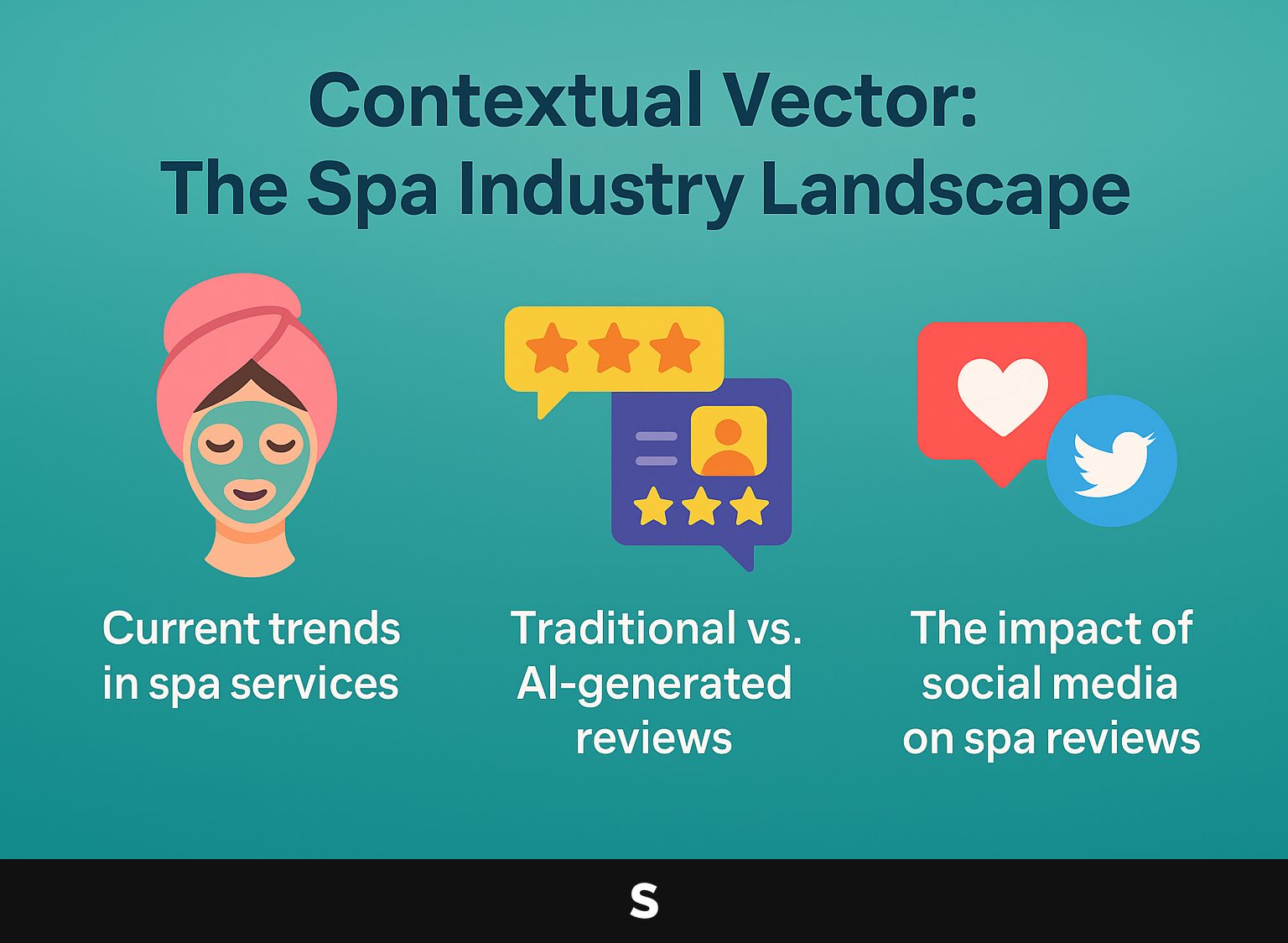
Current trends in spa services and customer expectations
Current trends in spa services focus on complete care, tailoring experiences for each customer, and using new technologies to meet changing customer needs.
Spas are increasingly creating treatment plans based on each client’s preferences and skin type. For example, using skin analysis devices can help therapists suggest facials suited for different skin conditions.
Using services such as aromatherapy and guided meditation improves the overall experience. A recent survey shows that 65% of people who visit spas now look for treatments for both their body and mind, showing a move towards combined wellness options.
Comparing traditional reviews vs. AI-generated reviews
Comparing traditional reviews with AI-generated reviews reveals significant differences in detail and emotional resonance that can influence potential clients.
Traditional reviews often include general comments and personal views, which makes them based on personal feelings. AI-generated reviews can look at lots of data to provide a thorough view, unlike traditional reviews.
For instance, an AI model like OpenAI’s GPT can parse thousands of user comments to highlight trending sentiments or specific product features.
Traditional reviews are usually brief. AI-created reviews, on the other hand, clearly show how happy customers are and identify common issues. This method shows clearly how the product functions and what customers feel about it.
Social media has changed how spa reviews are shared, allowing immediate responses and expanding the audience for customer feedback.
Spas use Instagram and Facebook to visually display their environment and services, drawing in potential clients with appealing photos and videos.
For instance, the ’30 Days of Self-Care’ campaign by a Vancouver spa invited followers to share daily wellness tips, driving engagement and encouraging user-generated content.
The use of Facebook Ads by a Miami spa resulted in a 40% increase in online bookings after targeting local wellness enthusiasts. These examples underline the importance of strategic social media use in shaping positive customer perceptions.
Future of Spa Reviews
The way we review spas will change due to new technology, changing consumer tastes, and the increasing demand for genuine and trustworthy feedback. This shift reflects broader trends in the hospitality industry, where mastering customer experience is key to adapting to evolving standards. For more insights, check out how these changes are influencing the sector in our Mastering Customer Experience In Hospitality article.
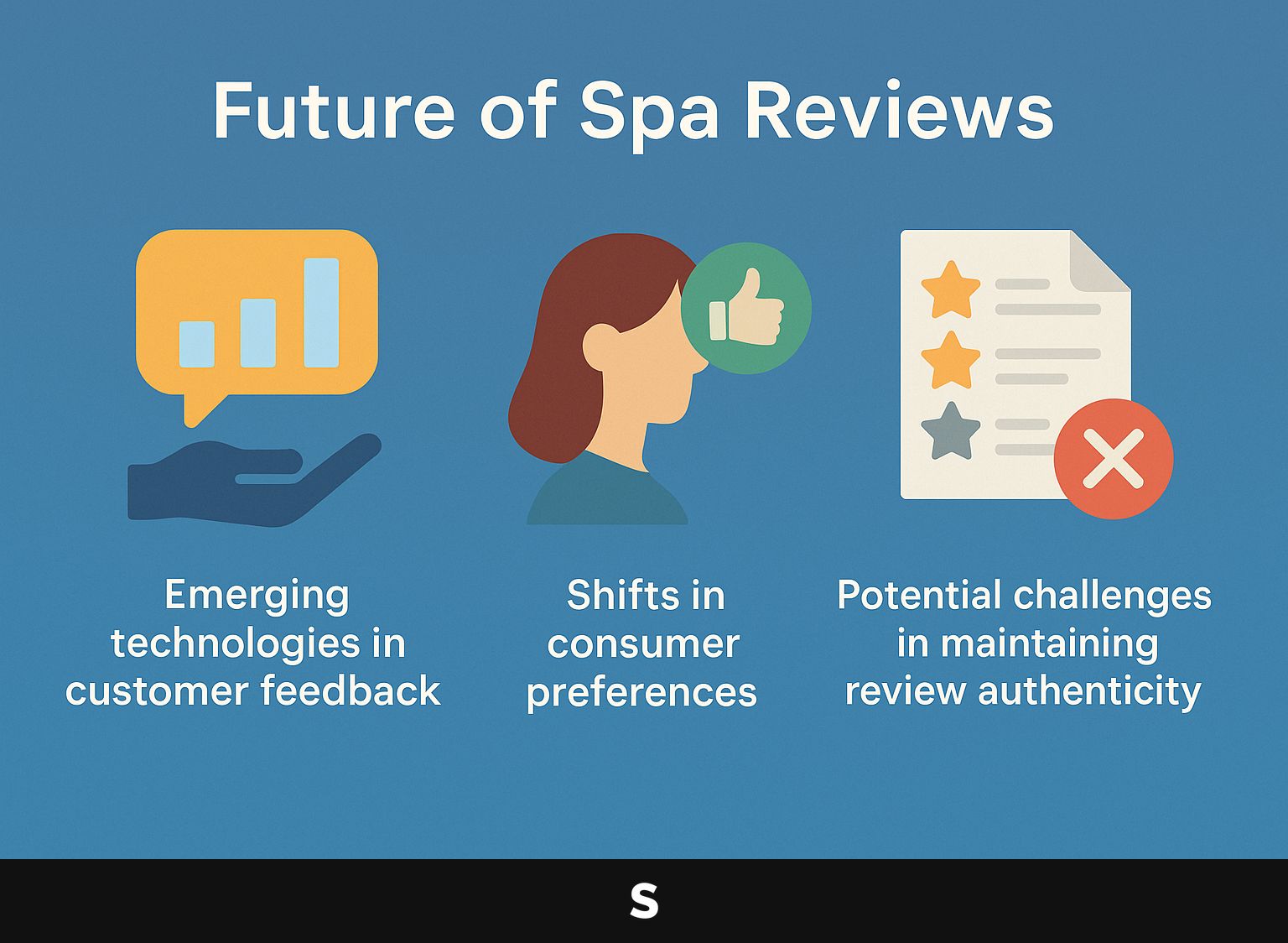
Emerging technologies in customer feedback
Emerging technologies such as AI and machine learning are revolutionizing customer feedback processes, enabling spas to gather and analyze reviews more effectively.
Spas can use sentiment analysis tools like MonkeyLearn or Lexalytics to review customer feedback and gather useful information. These tools can identify common themes in reviews, helping spa managers focus on areas that need improvement.
Systems for collecting feedback right away, like in-app surveys or QR codes that ask for customer ratings right after a service, allow for quick feedback. By using these technologies, spas improve their service quality and build stronger customer relationships, adjusting quickly to guest preferences.
Shifts in consumer preferences and experiences
Changes in what customers like show a need for services that fit their unique desires, as people more often look for options that match their personal requirements.
To change, spas can provide customized services based on client feedback and new wellness trends. Using client surveys to understand their preferences can result in treatments designed specifically for them, such as custom facial masks or unique massage methods.
Spas can stay ahead by integrating emerging trends such as CBD-infused therapies or virtual wellness consultations. Thermae Bath Spa has rolled out custom wellness packages. These packages are drawing in more customers by prioritizing personal health objectives and tastes, showing that a customized method works well.
Potential challenges in maintaining review authenticity
Maintaining review authenticity presents challenges for spas, especially in the face of rising concerns about fake reviews and manipulated feedback.
To address these problems, spas can put various plans into action.
- First, ask customers to provide feedback by sending automatic follow-up emails after their visits, which helps gather honest opinions.
- Use review management tools such as Trustpilot or ReviewTrackers to track and verify reviews.
- Be open when replying to reviews, deal with any issues, and explain how customer feedback influences services.
By using these methods, spas can gain trust and improve their reputation in a challenging market.
Frequently Asked Questions
What does Spokk.io do?
Spokk.io helps spas get reviews that convey ambiance and relaxation.
How does Spokk.io help spas get reviews?
Spokk.io uses AI to write custom reviews from client feedback.
Why is it important for spas to have reviews that capture the full experience?
Thorough reviews of the spa experience can draw in new clients and help build trust with potential customers.
What are some examples of reviews that Spokk.io can generate?
Spokk.io can create reviews like “As soon as I entered, the relaxing environment and scents made me feel peaceful” and “My massage therapist Maria was knowledgeable and focused.”
Can spas customize the reviews generated by Spokk.io?
Yes, spas can make changes or add their own personal touch to the reviews generated by Spokk.io.
Is Spokk.io only for spas?
No, Spokk.io can be used by other businesses in the wellness and relaxation industry, like salons and yoga studios, to collect individual reviews from clients.

